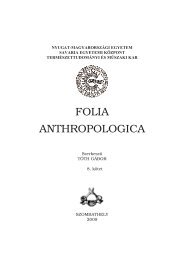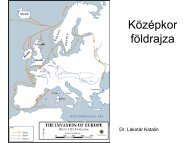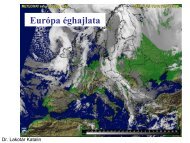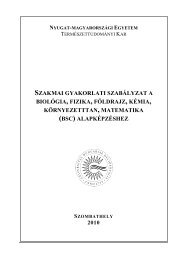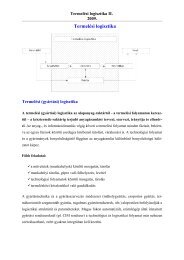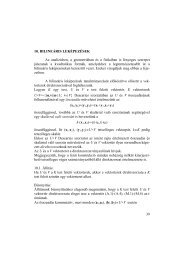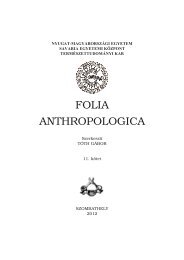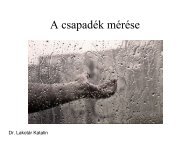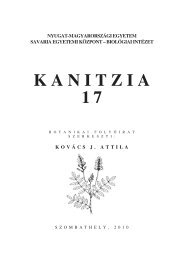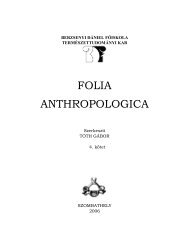Kanitzia 18. - NYME Természettudományi Kar - Nyugat ...
Kanitzia 18. - NYME Természettudományi Kar - Nyugat ...
Kanitzia 18. - NYME Természettudományi Kar - Nyugat ...
Create successful ePaper yourself
Turn your PDF publications into a flip-book with our unique Google optimized e-Paper software.
Festuca. Lately the species of Festuca arenicole in the Danube Delta area and the<br />
coastline were more thoroughly explored. Apart from F. arenicola (Prodan) Soó – of different<br />
taxon positions (Bas.: Festuca pallens Host subsp. arenicola Prodan; Festuca cinerea<br />
Vill. subsp. arenicola (Prodan) Beldie; Festuca vaginata Waldst. & Kit. var. arenicola (Prodan)<br />
Soó & Simon) with the synonim: Festuca pallens Host subsp. mamaiae Prodan; Festuca<br />
pallens Host var. mamaiae (Prodan) Beldie; taxon ackowledged in Flora Europaea<br />
(MARKGRAF-DANNENBERG 1980: 147) CIOCÂRLAN (2009: 1009) mentions it on the coastline<br />
sands in Rm and NE Bulgaria (where we collected it in 2008, from the coastline sand at<br />
Duranculac HGN); other species indicated in our country:<br />
164. Festuca beckeri (Hack.) Trautv. (incl. subsp. beckeri) (syn. Festuca ovina L. subsp.<br />
beckeri Hack.) /POA/ – according to our researchers, it is also encountered in our country<br />
(DIHORU 1987): BR: Movila Miresei; TL: Delta Dunării: Letea, Grindul Letea ut Cardon;<br />
CT: Mamaia (DIHORU 1987). According to Ciocârlan (2009: 1009) the species does not<br />
grow in Rm. After Soó (1955: 198), F. beckeri is a pontic and aralocaspic element while F.<br />
polesica is a northern Baltic one (SOÓ 1955: 197). I believe that F. arenicola grows on the<br />
coastline and continental sands in the regions of lower Bârlad and SW Brăila, while F.<br />
beckeri is a pontic and aralocaspic element and F. polesica is a Baltic element; they may<br />
be vicariant taxa in the affinity area of the F. vaginata.<br />
165. Festuca polesica Zapał. (Festuca beckeri (Hack.) Trautv. subsp. polesica (Zapał.)<br />
Tzvelev) /POA/ – mentioned by us on the sands in the region of lower Bârlad, Hanul Conaki<br />
(CIOCÂRLAN 2009: 1009). Reservatio "Hanul Conaki" (DIHORU 1987). Iveşti (CIOCÂRLAN<br />
1998: 20). In silva Drăgăneşti (DIHORU 1987). In silva Torceşti; Blăjerii de Sus; inter<br />
Diechieni–Călmăţui–Hanul-Conaki (OPREA 1998). TL: Delta Danubii, in silva Letea (ROMAN<br />
1992: 51). Nevertheless 6000 years ago the Black Sea coastline spread up to Hanul-Conaki<br />
area and to the sands SW of Brăila and many plants here seem relics of that period (Aeluropus<br />
littoralis, Hymenolobus procumbens, Juncus maritimus, strictly littoral plants).<br />
166. Filipendula ulmaria (L.) Maxim. subsp. picbaueri (Podp.) Smejkal /ROS/ – SB: dextra<br />
rivuli Pârîul Strâmb, prope confluentio cum rivulum Pârîul Ruşciorul (SCHNEIDER-<br />
BINDER 1976). Chorology: Atlas Fl. Eur. map 3284 (KURTTO et al. 2004: 38).<br />
Fraxinus L. More taxa and fito-geographical information was gathered regarding<br />
the ashtree in our country. Still we don’t have a clear unitary point of view about the ashtrees<br />
in our country. More and more botanists and still more sylviculture specialists indicate the<br />
plain regions, especially the ones in the Romanian Plain- Fraxinus excelsior, though this<br />
taxon grows in regions of hills and mountains and moderate wet areas. It is interesting that a<br />
peasant in the Plateau of Mehedinti, at the foot of the Mehedinti Mountains (Giurgean, Giurgeni<br />
- Isverna) knew that and when asked if he could show me a “black” ashtree he answered<br />
it was quite scarce there in that chalky stone area and that it only grew in the mountains.<br />
There is also a PhD diss. at the Faculty of Sylviculture Univ. Brasov, which unfortunately I<br />
could not see. Flora Europaea brought some clarifications concerning the ashtrees (AMARAL<br />
FRANCO & ROCHA AFONSO 1972: 53) but not ultimate ones. Now it is known that the Fraxinus<br />
angustifolia Vahl is a plant with leaves without hairs, mainly growing in western areals. Other<br />
taxa replace it in plain regions like ours. One of them is:<br />
114




